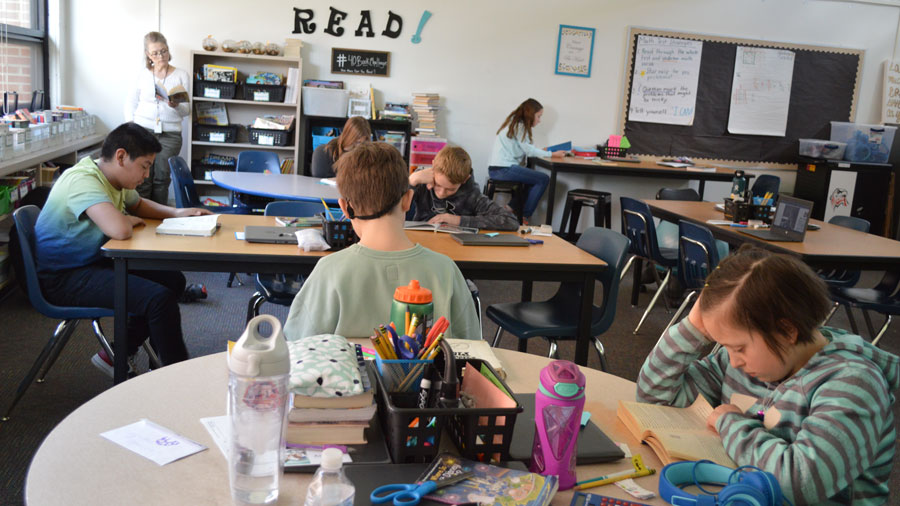Kent City — “Mrs. Goldner’s class has read 628 books” reads a sign on the door of a fifth-grade classroom at Kent City Elementary.
Sarah Goldner has challenged each of her students to read 40 books, from a variety of genres, by the end of the school year. Hilary Muelenberg, the school’s third- through fifth-grade reading coach, has been encouraging teachers to adopt a program like this for several years, but this is the first year Goldner has implemented it successfully. Having a system, Goldner said, has made all the difference.
Goldner’s students fill out Google forms when they finish a book, and Goldner tracks each student’s progress in a spreadsheet.
After submitting the survey, students meet with Goldner for a one-on-one conference about the book they read.
“The 40-book challenge isn’t supposed to be tied to any culminating event,” Goldner said. “We’re not supposed to do a book report or anything like that because that diminishes the thrill and the excitement of reading, but I wanted some way to check in with students.”
Goldner keeps notes on students’ reading experiences as talking points for future conferences. “It helps me kind of see their thought process,” Goldner said. In the conferences, she encourages students to make text-to-self connections.
Students have viewing access to the spreadsheet, so they can consult their progress when selecting a new book.

Reading Outside the Comfort Zone
Goldner has tweaked the genre breakdown of the original 40-book challenge, which was created by “The Book Whisperer” author Donalyn Miller, to fit her classes’ interests and needs. She chose to add graphic novels as an option, as well as additional “reader’s choice” options.
The challenge introduces students to a variety of genres, including nonfiction, historical and realistic fiction, poetry and biography while still giving them the freedom to choose which specific books they want to read.
“Here in Kent City we really prioritize student choice in books, which is wonderful,” Goldner said.
“By fifth grade, they have had a lot of experience to know what they like to read,” she added. “By having this 40 books challenge with the genres, it really forces them to maybe read outside their comfort zone.”
“It’s really just their own motivation, to see how much they can read.”
– Sarah Goldner
Fifth-grader Brooke Scheidel ventured outside her zone, and was glad she did.
“At first I thought I wouldn’t like [biographies],” Brooke said. “I read a few and I liked them a lot.” She read biographies of Temple Grandin and Anne Frank.
Brooke’s classmate Karis Larson had a similar experience: “I started liking to read historical fiction,” she said. “I got into realistic fiction, then I did biographies.” Karis said she liked historical fiction because “It tells me about the past. I thought I wouldn’t like it but I ended up liking it.”
Goldner has been working through the challenge herself, branching out into genres she usually doesn’t read. She shares her own experience of reading outside of her comfort zone with her students.
Intrinsic Motivation
Students’ motivation to make progress on the challenge, Goldner said, “really is coming from within.” The class celebrates collective milestones, like hitting a total of 500 books read, but “there’s no prizes or anything.”
Some students require more encouragement than others, but part of the philosophy of the challenge is “that it’s really just their own motivation, to see how much they can read,” Goldner explained.
She keeps track of who still needs to read which genres and helps her students find those books in the school library, but her in-classroom library gives students even more immediate access to new books. Each teacher at Kent City Elementary has a yearly budget dedicated to updating his or her classroom library.
Letting students make their own book selections based on their interests encourages them to keep reading, teachers agree.
“The story is what makes it entertaining,” fifth-grader Aubrey DeBoer said, explaining why she stuck with a series of fiction books.
Along with several other students in the class, Aubrey has already completed the challenge. Still, she continues adding to her “extra books” list.











